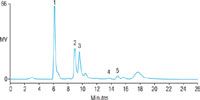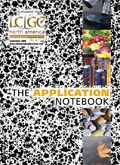Rapid Solvent Extraction for Alternative Fuel Research
As global interest in alternate fuel sources increases, many laboratories are researching effective ways to test, develop, and produce fuel from renewable energy sources.
Jennifer Peterson, Richard Carlson, Bruce Richter, and David Knowles, Dionex Corporation
As global interest in alternate fuel sources increases, many laboratories are researching effective ways to test, develop, and produce fuel from renewable energy sources. One of these is the production of alcohol from biomass, called bioalcohol. As bioalcohol is produced from biomass via sugar fermentation, it is necessary to research which types of plants produce the best yields of usable sugars.

Figure 1: LC characterization of switchgrass pretreated with 0.2% H2SO4. Peaks: 1) DP4+, 2) glucose, 3) xylose, 4) arabinose, 5) acetic acid.
Research was conducted using the new Accelerated Solvent Extraction instruments (ASE® 150 and 350) from Dionex with pH-hardened pathways to extract pre-hydrolyzed biomass samples and to perform in-cell hydrolysis using acidified extraction solvents.
Acidified Solvent Extraction (In-Cell Hydrolysis)
Corn stover* samples were extracted for the quantifiable determination of sugars used for ethanol production. Two different extraction temperatures were examined to determine the best method. A set of corn stover samples were extracted in 66 mL Dionium™ extraction cells using a 0.1 M H2SO4 solution at 150 °C while a second set of samples were extracted with the same acidified solvent at 190 °C. Each set of samples was extracted with three 5 min static cycles.

Figure 2: LC characterization of switchgrass pretreated with 0.5% H2SO4. Peaks: 1) DP4+, 2) glucose, 3) xylose, 4) arabinose, 5) acetic acid.
Results showed that the samples extracted at 190 °C produced more total extractables at 87.3% compared to 48.7% when extracted at 150 °C. However, HPLC analysis showed that this higher temperature caused a breakdown of the sugars and coextractable material. Analysis of the extracts at 150 °C showed no breakdown of sugars and no unwanted coextractables.
*Corn stover consists of the leaves and stalks of maize plants left in a field after harvest and includes the residue stalk, the leaf, husk, and cob.
Pre-Hydrolyzed Samples
Two different concentrations of acidic solvents were examined for hydrolysis of switchgrass samples to determine the optimal concentration for recovery of glucose. Two sets of switchgrass samples were mixed with the two different concentrations of solvent in a beaker and allowed to hydrolyze at 200 °C. The samples were then extracted in a 66 mL Dionium cell using HPLC-grade water at 100 °C. Each set of samples was extracted with three 7 min static cycles.
The HPLC analysis showed that for samples pretreated with 0.2% H2SO4, xylose was the predominant sugar present (Figure 1). Samples pretreated with 0.5% H2SO4 had a significant increase in glucose levels (Figure 2).
Acknowledgements
The ASE method for extraction of corn stover samples was developed by NREL in Golden, Colorado.
The data from the switchgrass samples is courtesy of Dr. Doug Raynie from South Dakota State University (SDSU) Dept. of Chemistry and Biochemistry.
ASE is a registered trademark and Dionium is a trademark of Dionex Corporation.

Dionex Corporation
1228 Titan Way, P.O. Box 3603, Sunnyvale, CA 94088
tel. (408)737-0700; fax (408)730-9403
Website: www.dionex.com

SEC-MALS of Antibody Therapeutics—A Robust Method for In-Depth Sample Characterization
June 1st 2022Monoclonal antibodies (mAbs) are effective therapeutics for cancers, auto-immune diseases, viral infections, and other diseases. Recent developments in antibody therapeutics aim to add more specific binding regions (bi- and multi-specificity) to increase their effectiveness and/or to downsize the molecule to the specific binding regions (for example, scFv or Fab fragment) to achieve better penetration of the tissue. As the molecule gets more complex, the possible high and low molecular weight (H/LMW) impurities become more complex, too. In order to accurately analyze the various species, more advanced detection than ultraviolet (UV) is required to characterize a mAb sample.















